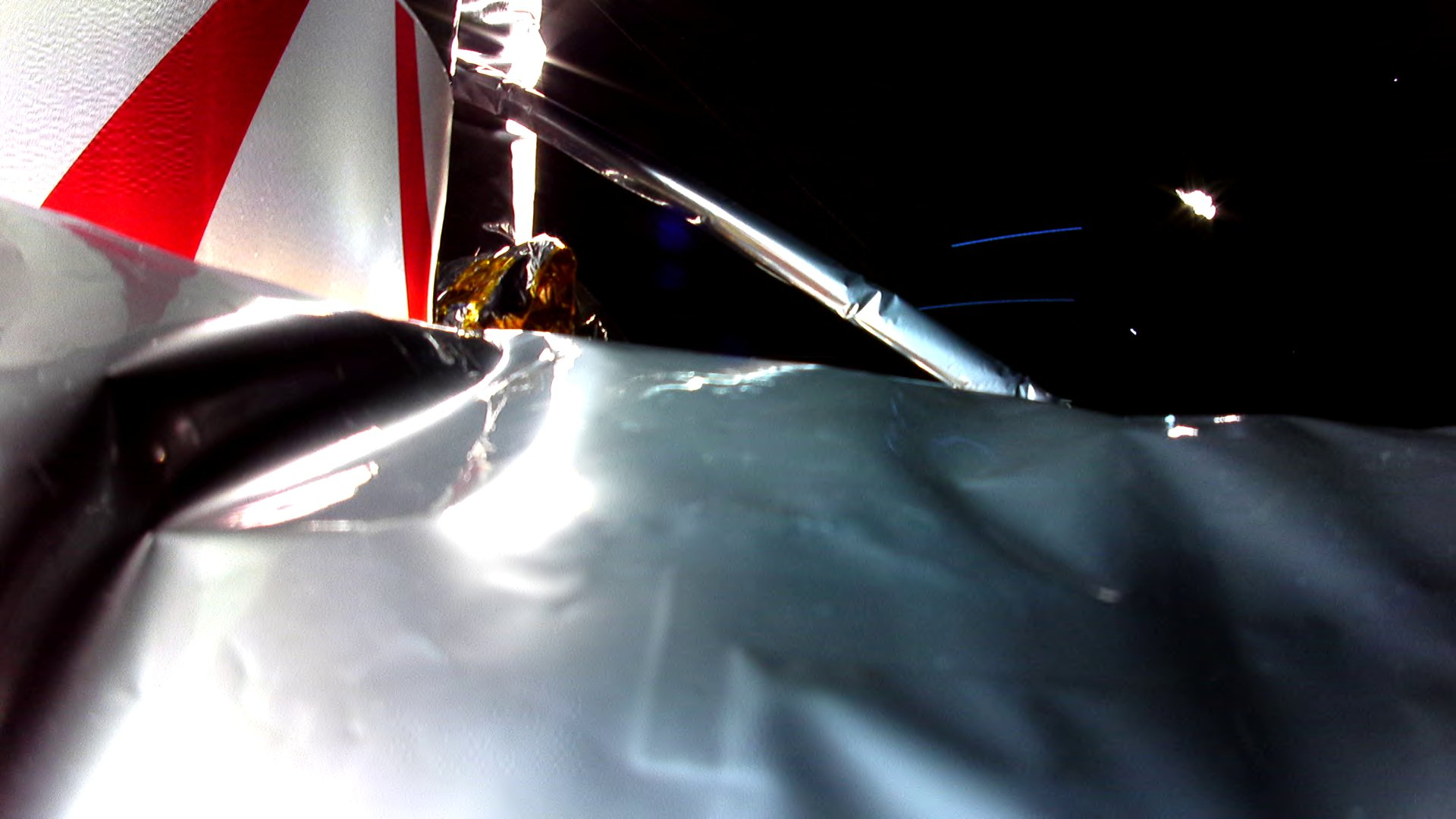Update for 4 p.m. EST on Jan. 9: In an update today, Astrobotic reported that its Peregrine moon lander has lost so much propellant that it will not be able to attempt a moon landing on Feb. 23. The lander will run out of fuel in the upcoming days and Astrobotic will "unable to continue operating the vehicle as a spacecraft." Read our full story and update here.
Astrobotic's troubled Peregrine moon lander has snapped its first photo in the final frontier, and the image holds clues about what happened to the spacecraft.
Peregrine lifted off early Monday morning (Jan. 8) on the first-ever mission of United Launch Alliance's new Vulcan Centaur rocket. The historic launch went well, but Peregrine ran into problems shortly after deploying from the rocket's Centaur upper stage.
The lander failed to orient itself properly to face the sun to charge its solar panels, an issue that Astrobotic thinks stemmed from an anomaly in Peregrine's propulsion system. That hypothesis was bolstered by the first image the lander snapped in space, which the company shared today via X (formerly known as Twitter).
"The camera utilized is mounted atop a payload deck and shows Multi-Layer Insulation (MLI) in the foreground," Astrobotic wrote in the X post that featured the photo. "The disturbance of the MLI is the first visual clue that aligns with our telemetry data pointing to a propulsion system anomaly."
Related: Private Peregrine moon lander suffers 'critical' fuel loss after launch, mission at risk

Peregrine aimed to pull off the first-ever moon landing by a private spacecraft, a milestone targeted for Feb. 23 or thereabouts. It doesn't look like that's going to happen, however; the anomaly has caused a "critical loss of propellant," and Astrobotic is now looking into alternative mission scenarios.
Get the Space.com Newsletter
Breaking space news, the latest updates on rocket launches, skywatching events and more!
There is some good news, however: The mission team has managed to get the lander's battery fully charged, "and we are using Peregrine's existing power to perform as many payload and spacecraft operations as possible," Pittsburgh-based Astrobotic wrote in that same X post.
Peregrine flew on Monday as part of NASA's Commercial Lunar Payload Services (CLPS) program, which arranged to get five agency science instruments on the lander.
It was the first launch for CLPS, which aims to boost lunar research ahead of crewed visits to the moon via NASA's Artemis program later this decade. The next CLPS mission is targeted for next month, when Houston company Intuitive Machines' Nova-C will lift off atop a SpaceX Falcon 9 rocket.
Join our Space Forums to keep talking space on the latest missions, night sky and more! And if you have a news tip, correction or comment, let us know at: community@space.com.

Michael Wall is a Senior Space Writer with Space.com and joined the team in 2010. He primarily covers exoplanets, spaceflight and military space, but has been known to dabble in the space art beat. His book about the search for alien life, "Out There," was published on Nov. 13, 2018. Before becoming a science writer, Michael worked as a herpetologist and wildlife biologist. He has a Ph.D. in evolutionary biology from the University of Sydney, Australia, a bachelor's degree from the University of Arizona, and a graduate certificate in science writing from the University of California, Santa Cruz. To find out what his latest project is, you can follow Michael on Twitter.
-
tubefreak Reply
SO - we're not happy with polluting our own planet. We're now going to open the door for anyone with the money to use the moon for, among other things, a graveyard ? Such arrogance !!Admin said:The photo shows a disturbance in some of Peregrine's insulation, which is consistent with a problem in the moon lander's propulsion system.
1st photo from crippled private Peregrine moon lander holds clue to anomaly : Read more -
kehvan Reply
Smhtubefreak said:SO - we're not happy with polluting our own planet. We're now going to open the door for anyone with the money to use the moon for, among other things, a graveyard ? Such arrogance !! -
grrlrocks What is the light source for the photo? Where is it located? The light source is apparently NOT on/next to the camera - why not? It actually looks like there are MULTIPLE light sources, or directions! Why no explanation for 2 small bluish streaks (one is quite faint) and another 2 "lights" seen off the lander (one is quite small)? Can you show a pic of the lander that shows EVERYTHING shown in the pic? Other pix of the lander do NOT show the red & white striped thingy, which btw I do not believe was not identified in the article. WTH. You all want us to believe this is real yet leave us with more questions than we had before!Reply -
Pogo The light source is likely the Sun, and any additional is likely sunlight reflected from parts of the spacecraft. Streaks may be camera artifacts, the larger spot is probably the tip of something on the spacecraft, the remainder of that in shadow. The faint white spot may be a star. -Reply -
bolide Also the anomaly was probably a rupture of a propellant tank, which would expose materials (eg insulation) that were not exposed before.Reply









